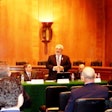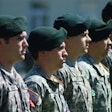In the world of gangs, the word "Sureño" is generally used to identify Hispanic gang members from Southern California, those loyal to the California Mexican Mafia prison gang. However, the Sureño movement has also infected local gangs in Northern California, Nevada, Colorado, New Mexico, Utah, Texas, and Arizona. In fact Los Angeles born "Sureño-Transnational" gangs like Florence, 18th Street, and Mara Salvatrucha (MS-13) have established the Sureño movement internationally.
The Sureño movement is very strong among Hispanic gangs along the southern border. Today local Southwest sheriffs, police, Border Patrol agents, and ICE Agents commonly come in contact with Sureño gang members who have never been to California and some who have only recently entered the United States for the first time.
Twenty-five miles south of Yuma, Ariz., is the tiny border town of San Luis. The U.S.-Mexico borderline cuts through San Luis dividing it into San Luis, Arizona, and San Luis, Mexico. The Mexican side of the city is in the Mexican state of Sonora and is home turf for a Mexican Sureño gang known as "Los Wonders" or "The Wonder Boys."
The area of the city that the gang controls is called La Colonia Del Rio, but the Wonder Boys have grown and expanded their territory into the U.S. side of San Luis. As such, the Los Wonders gang has become a significant problem for law enforcement on both sides of the border.
Like the larger criminal gang organizations from Mexico, the Wonder Boys specialize in human trafficking. They operate along the international border fence and west to the Colorado River bed. But they are also criminally diversified, committing crimes like car theft, robberies, assaults, extortions, organized prostitution, and home invasions, in support of their gang. Wonder Boys have been arrested for assault on police officers and some gang members have been homicide suspects.
Despite the severe gun restrictions imposed by Mexico, the Wonder Boys are known to carry firearms and other weapons. Caution is recommended for law enforcement officers encountering members of this gang.
The Mexican government has organized and successfully deployed several gang sweeps targeting the Wonder Boys and their "shot callers," but the gang persists.
Like their brother Southern California-based Sureños, the Wonder Boys spray paint gang graffiti and tattoo themselves with their gang symbols, "WB," "Wonder Boys," or "Wonder Bois." The gang often frequents the San Luis dance clubs and can be seen on the night club Web pages flashing gang signs.
No real Sureño gang would be complete without a rival or two, and the Wonder Boys are no exception. The El Callejon district of San Luis is the home turf for the "Chopas" gang, sworn enemies of the Wonder Boys. The Chopas gang members identify themselves and their vehicles by displaying a Chopas decal on the rear window. They have been seen in gang areas as far away as Yuma. In addition to their gang turf rivalry, Los Chopas are also rivals to the Wonder Boys in the illegal alien smuggling trade.
A second rival gang is another Mexican Sureño gang known as "Los Demonios" (The Demons). These charming Latin lads are also based in the Mexican section of San Luis.
The members of all three of these Mexican Sureño gangs mimic the California-Arizona "Cholo" look. They wear shaved heads or #1 close-cut haircuts, baggy Friscos or Dickies pants, oversized white t-shirts, and white Nick Cortez tennis shoes laced with blue or black shoe strings are traditional. This gangster style is referred to as "tumbado" in Spanish. Sport clothing like football jerseys featuring the number 13 and the colors black or blue and tattoos like "trece," "sur-13," "South Sider," and "Sureño " are also common to Sureño gangs.
Mexican authorities continue to report a steady rise in "Sureño" gang activity in San Luis, Mexico. This has become a serious concern for both Mexican law enforcement and the general public.
I have chosen these three gangs as examples of what I believe is happening all along the "Frontera" but is largely unreported. I believe this Mexican Sureño movement will continue to spread along the Southwest border towns. These Mexican border Sureños will also be more likely to have direct ties to the drug and human trafficking organizations and will continue to be a dangerous challenge to U.S. and Mexican law enforcement for the near future.
In addition to these Mexican Sureño gangs, the Yuma sector Border Patrol agents report that they have encountered and arrested Sureño street gang members from:
Baker Trece-Bakersfield, Calif.
18th Street-Arlington, Va.
Barrio Vagos-Salinas, Calif.
Dog Patch-Cucamonga, Calif.
Hollywood Hobart Tiny Ones-Los Angeles
White Fence-Los Angeles
Crazy Riders-Los Angeles, Calif.
Little Town-San Luis, Ariz.
Border Brothers-Various parts of Mexico
Lomas Trece-Los Angeles
Florence Trece-Los Angeles
South Sider Trece-Las Vegas
Orange County Trece-Orange County, Calif.
Sureño Trece, (East Los Angeles Clique)-Los Angeles
Mara-Salvatrucha -El Salvador, Guatemala, Honduras, and Mexico
I am writing this report while the closure of the Tijuana-San Diego border crossing is being reported because of a shootout between Border Patrol agents and human traffickers and after a high-ranking U.S. ICE official, Richard Padilla Cramer, was arrested this month for corruption charges.
Much of the information used for this article was taken from a Border Patrol article written by Joe Preciado, lead Border Patrol agent, Yuma Sector Intelligence Unit.



















